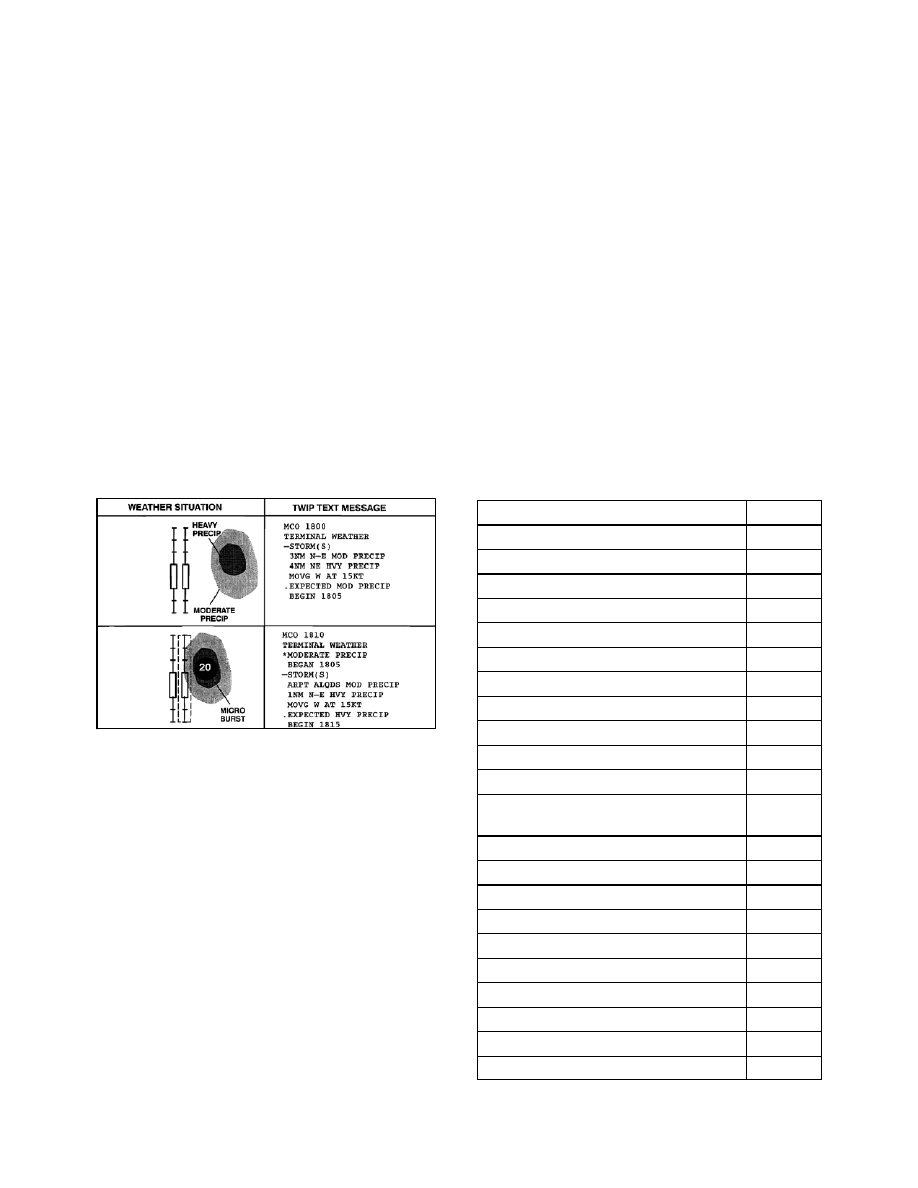
AIM
8/15/19
7
−
1
−
56
Meteorology
6. The Terminal Weather Information for
Pilots System (TWIP).
(a)
With the increase in the quantity and
quality of terminal weather information available
through TDWR, the next step is to provide this
information directly to pilots rather than relying on
voice communications from ATC. The National
Airspace System has long been in need of a means of
delivering terminal weather information to the
cockpit more efficiently in terms of both speed and
accuracy to enhance pilot awareness of weather
hazards and reduce air traffic controller workload.
With the TWIP capability, terminal weather
information, both alphanumerically and graphically,
is now available directly to the cockpit at 43 airports
in the U.S. NAS. (See FIG 7
−
1
−
20.)
FIG 7
−
1
−
20
TWIP Image of Convective Weather
at MCO International
(b)
TWIP products are generated using
weather data from the TDWR or the Integrated
Terminal Weather System (ITWS) testbed. TWIP
products are generated and stored in the form of text
and character graphic messages. Software has been
developed to allow TDWR or ITWS to format the
data and send the TWIP products to a database
resident at Aeronautical Radio, Inc. (ARINC). These
products can then be accessed by pilots using the
ARINC Aircraft Communications Addressing and
Reporting System (ACARS) data link services.
Airline dispatchers can also access this database and
send messages to specific aircraft whenever wind
shear activity begins or ends at an airport.
(c)
TWIP products include descriptions and
character graphics of microburst alerts, wind shear
alerts, significant precipitation, convective activity
within 30 NM surrounding the terminal area, and
expected weather that will impact airport operations.
During inclement weather, i.e., whenever a predeter-
mined level of precipitation or wind shear is detected
within 15 miles of the terminal area, TWIP products
are updated once each minute for text messages and
once every five minutes for character graphic
messages. During good weather (below the predeter-
mined precipitation or wind shear parameters) each
message is updated every 10 minutes. These products
are intended to improve the situational awareness of
the pilot/flight crew, and to aid in flight planning prior
to arriving or departing the terminal area. It is
important to understand that, in the context of TWIP,
the predetermined levels for inclement versus good
weather has nothing to do with the criteria for
VFR/MVFR/IFR/LIFR; it only deals with precipita-
tion, wind shears and microbursts.
TBL 7
−
1
−
11
TWIP
−
Equipped Airports
Airport
Identifier
Andrews AFB, MD
KADW
Hartsfield
−
Jackson Atlanta Intl Airport
KATL
Nashville Intl Airport
KBNA
Logan Intl Airport
KBOS
Baltimore/Washington Intl Airport
KBWI
Hopkins Intl Airport
KCLE
Charlotte/Douglas Intl Airport
KCLT
Port Columbus Intl Airport
KCMH
Cincinnati/Northern Kentucky Intl Airport
KCVG
Dallas Love Field Airport
KDAL
James M. Cox Intl Airport
KDAY
Ronald Reagan Washington National Air-
port
KDCA
Denver Intl Airport
KDEN
Dallas
−
Fort Worth Intl Airport
KDFW
Detroit Metro Wayne County Airport
KDTW
Newark Liberty Intl Airport
KEWR
Fort Lauderdale
−
Hollywood Intl Airport
KFLL
William P. Hobby Airport
KHOU
Washington Dulles Intl Airport
KIAD
George Bush Intercontinental Airport
KIAH
Wichita Mid
−
Continent Airport
KICT
Indianapolis Intl Airport
KIND